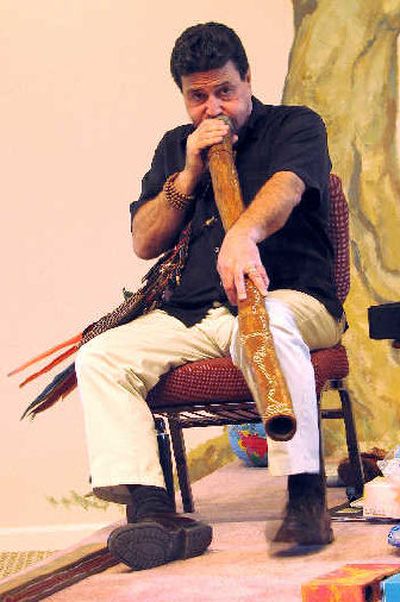Didgeridoo state of mind

In the novelty song “Tie Me Kangaroo Down,” a dying Australian stockman asks for several deathbed favors, including:
“Play your didgeridoo, Blue, play your didgeridoo. Like, keep playing it ‘til I shoot through, Blue, play your didgeridoo.”
If the old boy had been at the Unity Center in north Spokane on Sunday afternoon, he would have had his last wish in spades. The event was billed as Meditation and Breath Work with the Australian Didgeridoo.
Phil Jones, an Australian musician and didgeridooist extraordinaire, was giving a first lesson to some 25 newbies desiring instruction. Jones brought 35 aborigine-crafted didgeridoos from Australia and bid the new class members coming in the door to look at the collection and select the didgeridoo to which he or she is “drawn.”
The didgeridoo is a drone instrument that originated in Australia about 50,000 years ago. Most of Jones’ instruments were about 4 feet long and decorated with various figures that give some indication of the artisan’s home region in Australia.
Didgeridoos are made from a big branch of selected species of the Australian eucalyptus tree that has the interior eaten out by white ants (termites). The work of the ants provides the sound chamber throughout the length of the instrument. Aborigines cut the branch off and take about six weeks to make it ready for play.
Jones provides antibacterial wipes so that each attendee can sanitize the beeswax end (about the size of a coffee cup) where they will place their mouths, and by “pouting” their bottom lips with their mouth closed, blow out to make their lips vibrate like a tuba player. Low soft breath, cheeks full of air and something called “circular breathing” are the keys to getting that low rich sound. A unique vibration in the wood instrument confirms to new players that they are making the intended sound, although 24 other new didgeridooists are honking away in the same room.
No virtuosos are created in the two-and-a-half-hour session but nearly everyone went from sounding like air out of a flat tire to moments of the deep rich resonance of which the didgeridoo is capable. Some higher instruction is briefly offered. “Twanging” and tongue or voice modulation allows the accomplished player to play varied tunes and imitate animal sounds, especially bird calls favored by the Australian aborigines.
After instrument instruction, Jones explains how the human mind can be cleared and a meditative state achieved more quickly by playing the didgeridoo. He points out that some individuals who are not seeking a spiritual or religious benefit from the didgeridoo, use the instrument to become more “clear and focused” of mind for business or personal considerations.
At least five minutes a day on the didgeridoo is recommended.
Jones recommends the didgeridoo to accelerate mind preparation for any kind of meditation.
Jones sprinkles the instruction with lots of humorous anecdotes and Australian lore. He contends that the Australian aborigine has created the didgeridoo as a gift to humanity.
It’s a gift for living a better life, ” ‘til you shoot through, Blue.”